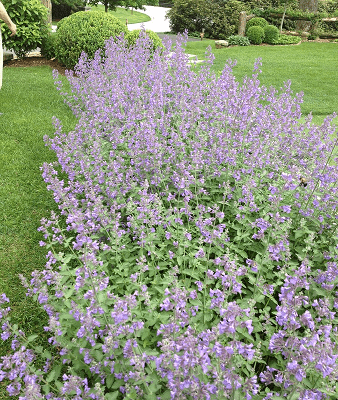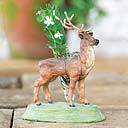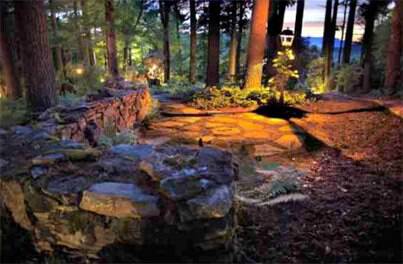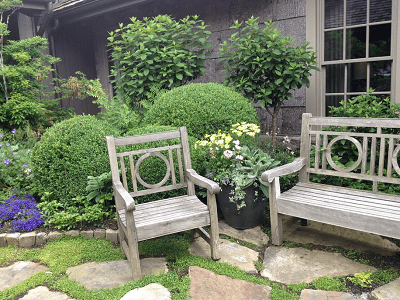Our team at Dovecote in Cashiers, NC is installing a hobbit hole — for our miniature garden lovers!

Create Nourishing Flourishing Home Utopias
Our team at Dovecote in Cashiers, NC is installing a hobbit hole — for our miniature garden lovers!


When decorating our homes we generally choose a color scheme and then create focal points with contrasting colors. Often when gardening however, we create color explosions due to the vast array of plant types and colors available. Using your garden much like an artist uses a blank canvas, you can easily be creating focal points with garden color palettes.
Even a carefully thought out garden plan might look jumbled and lack cohesiveness when you have many colors in bloom at once. Monochromatic schemes can provide a soothing yet far from boring alternative to such garden spaces. If you would not enjoy a fully monochromatic scheme, you might opt to use one as a border, or for focal points to break up the variegated colors. To create a monochromatic scheme, choose plants with blooms in similar colors, such as blues, mauves, and purples. To create texture and depth throughout the space in your garden, use plants that vary in height.
Another means of creating focal points with garden color palettes is to create a virtual river or lake of plants. Since it takes multiple plants to create this effect, you should choose a plant that spreads easily and grows quickly to keep costs down. Choose one color for your “water” and use only one or two plants to make the best impact. Add structure using well-placed shrubs, grasses, or even boulders. If using tall blooms for your river effect, consider creating a “shoreline” with low plants in a contrasting color to define the edges.
Dargan Landscape Architects has been designing Utopian gardens for nearly 40 years. We invite you to browse our online designs and contact us to design your perfect garden.
Part of the fun in designing your garden is to create unique displays that are not only beautiful, but also include hints of your personality. Our Boundless Garden product line includes a wide variety of decor items to appeal to all tastes and style types. Today we will feature how to add an eclectic vibe to your garden with our animal garden vases.
 Rabbits with glass stand six inches tall and are available in white or bisque. Each rabbit is finely detailed, carries a wire-woven basket, and sports a glass vase just waiting for your imagination. Use these lovely creatures to create beautiful spring centerpieces or combine them with some of our other animal vases to create a whimsical look in your garden.
Rabbits with glass stand six inches tall and are available in white or bisque. Each rabbit is finely detailed, carries a wire-woven basket, and sports a glass vase just waiting for your imagination. Use these lovely creatures to create beautiful spring centerpieces or combine them with some of our other animal vases to create a whimsical look in your garden.
Squirrels can be a nuisance when designing a garden to attract other small wildlife, but our squirrel vase will only delight your visitors. Finely crafted in gray and white, this little guy will not steal food from your feeders since he carries his own coveted acorn. You might consider this vase as a centerpiece for fall displays or include it in a mixture of our animals.
 Reindeer with glass stands atop a green grassy knoll proudly showing off his antlers. Muscled and shaded to be realistic-looking, these reindeer come in a set of four ready to inspire creativity or perhaps become lovely centerpieces during the holidays.
Reindeer with glass stands atop a green grassy knoll proudly showing off his antlers. Muscled and shaded to be realistic-looking, these reindeer come in a set of four ready to inspire creativity or perhaps become lovely centerpieces during the holidays.
With its spindly legs and head turned as if tuned in to conversation with you, our white bird with glass stands 5 1/2 inches tall and can be used to show off flowers from every season. Used as centerpieces or interspersed through your garden as points of interest, these are a true delight.
If you prefer your birds with splashes of color, our warbler or thrasher will be sure to appeal. Designed to look like their friends from nature, these bright and detailed birds are poised for song. Decorate with wild flowers for your tables or place throughout your garden to attract their friends.
Dargan Landscape Architects invites you to view our full product line and contact us for design help.
Photos via Dargan Landscape Architects

Living close to water is an idyllic lifestyle that many people only dream of, however, it does come with a certain amount of responsibility to protect the wildlife that makes the coast its home. Ample lighting to enjoy your property and gardens in the evenings is necessary for your comfort, but there are often restrictions when living on the coast. We have some tips about landscape lighting for coastal gardens that will appease all affected.
Whenever possible, use motion sensors to control lighting that is designed for safety. Well-lit pathways to garden or seating areas near the beach are an example of such lighting. Not only will you be helping to protect the wildlife environment, you will realize energy savings with such areas lit up only when in use.
Spot lights and roof-mounted lights are particularly dangerous for coastal wildlife. Since they cast light into the trees and onto the shoreline, they can put animal habitats at risk and confuse newly-born wildlife such as sea turtles. If used at all, spotlights should be prevented from reflecting light towards the sky and should be angled at no greater than 90 degrees.
There are many subtle options when it comes to landscape lighting for coastal gardens. Recessed lighting can be used to cast soft light in covered areas, deck flooring, and stair treads. New LED styles include rope lights that let you get creative. Consider using them to outline garden areas, furniture, or other outdoor features for an interesting look.
At Dargan Landscape Architects, we understand the balance between ample lighting for your night-time enjoyment and wildlife protection when designing landscape lighting for coastal gardens. As licensed and storied landscape architects, we can help perfect your oasis. Contact us to discuss your plans today.

Evergreens are more than just a vibrant year-round plant addition; they provide a way to gain privacy and sound buffering, change up the texture in your landscape, or provide an attractive habitat for local birds and wildlife.
Pictures and Ideas for Incorporating Evergreens into a Landscape Design
For a quick primer on incorporating evergreens into a landscape design, we recommend watching this video, created at one of this summer’s Dovecote Summer Garden Talk Salons. It will provide important background information, so you can make better choices regarding the evergreen species you choose for your outdoor landscapes.
Here are a few ideas for additional inspiration:
Make it a focal point in a formal garden planter. In this garden, which takes its inspiration from formal English gardening techniques, the evergreen yew is the focal point of the planter. The pink blooms of the mid-perimeter geraniums create a colorful contrast to the surrounding greenery, including the exterior-perimeter boundary formed by boxwoods. The fun thing about this concept is that you can prune your yew and/or boxwoods into different sizes and shapes as the years progress. It’s an adaptable canvas.
Augment a new or existing garden accessory. If a garden accessory is your focal point, evergreens can be used to showcase it. I love how the holly plants surrounding this gorgeous oversized “bird cage” accessory have been pruned to mimic its shape. The variegated leaves echo the patina on the metal, creating a complete visual package.
Use evergreens to form living boundaries, privacy and sound relief. You can customize the size and shape of your evergreen selections to meet your need for living perimeter boundaries, such as the multi-level evergreens that create depth in this landscape plan. Trees can be grown much taller than typical building codes allow for fence lines, so they are ideal for creating privacy. Soft foliage and bark help absorb sound from a busy street, sidewalk, or from a public area of your landscape to a more private seating area.
Would you like professional assistance incorporating evergreens into your landscape? Schedule a consultation with Dargan Landscape Architects.
Contact us to kick things off. This will be more fun than you think!
Get In Touch